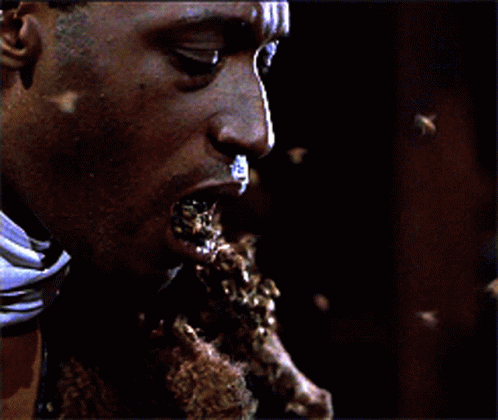“I’ve been trying to quit smoking. I want to take better care of my spiracles”
Like most others I have not read the article. But someone please answer me this:
If the bees fell asleep, then why didn’t the fire kill them? I can accept that insects don’t have lungs, I mean some people are doing well without hearts… but am I supposed to accept that bees are also immune to fire damage?
Put simply smoke doesn’t have to be hot. Smoke is just unburnt fuel caused by a process called offgassing (solid turning to a gas).
An example of cooled down smoke is a fire that starts in a well sealed room. It burns through as much fuel as possible, and while the solids are hot they turn into gas, however, due to a lack of oxygen, you don’t necessarily see combustion. So then the fire snuffs itself out and what you are left with is a cooling smoke.
So let’s say that the fire is on an upper floor. Heat goes up, cold goes down. So as smoke travels through a building it cools, and may eventually sink towards the ground or a lower level (this can be especially possible in a building as large as a cathedral) smoke sinks and interacts with bees at a “manageable temperature”.
Tldr: smoke isn’t always hot. The bees are happy.
The bees were on a different lower down roof from the main roof (which is the one that burned). The article notes that bee wax melts at 70C and they didn’t see any of that under the hives, so they know temperatures stayed below that. So the bees were likely only exposed to some smoke and maybe some slightly elevated temperatures.
Wait until this person hears about fish.
Why doesn’t the damaging and hot particulate matter in smoke do any harm to or otherwise clog up their spiracles like it does to the inner lining of lungs? I gather lungs are wet and also very delicate, but if they’re directly oxygenating their organs through these spiracles eventually it must get to somewhere wet and delicate for the smoke to get in and potentially harm.
Maybe something like:
- The spiracles stop working and the insect stops most major movements
- When the air becomes better, the new air fills the spiracles and reinvigorates the insect
vs
- Humans need to use their muscles to start breathing, or they will require external assistance
This is (fortunately) why there’s a maximum size on insects. The environment is less oxygen rich today than in the eras of giant insects in the past. They reach a size where oxygen can’t penetrate deeply enough onto their bodies.
It’s all based on a very fundamental mathematical law: if you increase the size of something, the volume increases with the third power while the surface area increases with the second power. An insect twice as large would be 8x as heavy and need 8x as much oxygen but 4x as much surface area.
That’s also the reason why insects are as strong as they are. The strength of a muscle scales primarily with the cross section area of it, which again scales with the second power. So if you’d increase the weight of an ant by a factor 10,000,000 (e.g. 5mg to 50kg), the expected strength would increase by 10,000,000^(2/3) ≈ 46,400. If it could lift 10x it’s weight at the original size, it could now only lift about 4.6% of it’s weight
Reminds me of how the damage to roads scales with the weight of the vehicle to the 4th power, so someone driving a 6000lb pickup does 16x more damage to roads than a 3000lb sedan
How does double the mass increase the damage 16 fold? I understand surface area vs volume, but that doesn’t seem relevant when working with mass
It’s more about a minimum of weight or pressure that affects it. So the higher the pressure the more likely it is to flex the road where a small vehicle with light pressure might not make it flex at all. The heavier it is the more the weight will flex the subsurface and cause more damage.
“To give you an example of that impact, let’s do a quick calculation. Here in New Zealand, the heaviest vehicle allowed on (some of) our roads is the 50MAX truck. It has nine axles and a total weight of 50 tonnes, so the load-per-axle is 5.55 tonnes. The best-selling car in NZ in 2022 was the Mitsubishi Outlander. It weighs 1.76 tonnes, so its load-per axle is 0.88 tonnes. The fourth-power law says that to calculate the relative stress that these two vehicles apply to a road, you take the ratio of their loads-per-axle and raise the result to the fourth power. In this case, (5.55 / 0.88)4 = 1582. In practical terms, it means that a 50MAX truck applies as much stress to a road as 1,582 cars (or quite literally billions of bicycles)”
On lungless insects. If they develop to be larger they will get lungs!
As long as they mutate it
As lung* as they mutate it.
maybe once I have money for hobbies, but I really want to make oxygen rich terrariums, and selectively breed tarantulas to see if I can make them larger.
As long as you leave the centipedes out of it
This is giving Island of Dr. Moreau
No!
Keep in mind it will be inherently escape proof.
if I manage to make meter wide spiders, they would suffocate as soon as they leave the enclosure.

although If they get big enough, I could have oxygen breathers I could attach to their tracheas.
try escaping my giant semi mechanised murder wasps
And a separate tank for Scorpions to fight them, we’ll make a killing
Yeah giant insects would be utterly terrifying (and deadly).
Next they’re going to tell me that bees don’t have hearts
they actually do, they have a “blood” vessel they use to transfer nutrients back and forth their bodies, no need for oxygen distribution though.
Well that’s a Christmas spiracle
don’t beekeepers use smoke or some such?
Yup. It simulates a forest fire and encourages them to gorge themselves on honey and leave the hive. They get less protective of the hive (because they think it is doomed) which makes it easier to work. They will check back in under an hour to see if the hive made it, and if so, will regurgitate the honey back and continue on with their day.
This sounds strange. You really don’t want to make them abandon the hive. You want to disrupt the hive as little as possible.
My main goal is to not get stung! Also you only go into the hives every few weeks so it’s not a major disruption. Also they only temporarily abandon the hive. They check on it later to see if it made it and then keep on living in it.
Never found even harvesting to require more than the occasional puff of smoke. But we had Buckfast, and made sure to replace the queen of any aggressive colony. Maybe you have more aggressive breeds.
For jarred honey with comb in it, how does that affect the hive?
Bee keepers move comb in and out of the hive frequently during the producing seasons. If they just cut the caps (top layer of wax) off the honeycomb, drain it, and then put the comb back in the hive, the bees have to use less energy to make comb, so they make more honey. If you put an “empty frame” (a spot with no honeycomb already on it) it takes the bees a lot more energy to make the comb so there is less honey. So it’s a trade off from the bee keepers’ perspective.
They stay in the hive if it’s not hot iirc
Yup, if it’s cold they stay inside the hive and ball up! They vibrate against each other to make heat and stay warm.
Bees are so fricking cool.
Fun additional bee fact! Bee hives have personalities and each hive has a different one! Some hives are very easy going and have no problems being worked. Other hives don’t like to be touched and will get defensive quickly. When working hives, one of the things you look for is bees lining up on the edge of a frame staring you down. If you see that, hit them with some more smoke else you are about to be stung!
Your comment prompted me to recall a great movie, https://en.m.wikipedia.org/wiki/The_Secret_Life_of_Bees_(film)
Love it! More!!!
Bees navigate using the sun. It doesn’t really seem that they make a map, but more seem to know where they are by the process of directions that got them there. When they return to the hive they just reverse the way they got there. If you stand in front of the entrance to a bee hive for a few minutes then turn around to face away from the hive, you will see a swarm of bees flying in a holding pattern waiting for you to move so they can return. Once you move the entrance to the hive gets really busy. They don’t seem to know to go around you, they just wait till the path is clear!
You realize I would have you posting bee facts all day if I could, right?
Here’s another for the road: mites are a big problem for bees. They latch on to the bees and the bees don’t feel them. One way bee keepers can encourage bees to clean themselves and knock off the mites is by covering the bees in powdered sugar! This makes it look like there are a bunch of powder white bees flying around for a while.
Yea tobacco smoke I think but want to say they were being stopped for that n9t sure.
I don’t believe they’d use tobacco, as nicotine is especially toxic to insects (and has a long history of being used as an insecticide).
Beekeepers burn paper, woodchips, or really anything that burns well that they have on hand (that isn’t toxic). Source: Have used smoker while handling beehives.
That makes sense after reading up more I believe I’m wrong I feel like I’d heard that they used nicotine and hadn’t fully researched and took it at face value. Thabks for the information!!
Looking around there does seem to be people who use tobacco. I guess poisoning the bees probably makes them more docile 😅 Still a bad idea though
am i the only one who notices that this logic makes no sense? it doesnt matter that they have no lungs, they still are susceptible to both heat and airborn toxins, they perform gas exchange. They lived because the heat and smoke were below lethal toxic levels for them.
this is true,
but the main takeaway is that some people learned that not all animals have or need lungs.
as a kid I assumed insect anatomy was like human but insect shaped, learning how alien they are for the first time is a fascinating experience I wish I could relive.
Insects don’t have lungs. It also means their potential size is directly limited by the oxygen content in the air.
Which is why we don’t see cat sized insects roaming around.
Related is this awesome video discussing dinosaur breathing
Which is why you don’t see cat sized insects roaming around, I live next to a tarantula trail and some of them fuckers get BIG.
Arachnids are not insects though.
tarantulas do indeed have lungs though
Wait… tarantula trails are a thing?
Yeah they followed paths, I think it’s a way of avoiding dangerous terrain. They are rather fragile beasts.
Spiders aren’t insects. Though like them, they don’t have lungs! Not ones like ours, anyway.
In my defense I am a smartass not smart.
Eh, you were close enough.
They breathe their own farts. Well.
And, for the most part, humans’ lungs don’t have bees!
I somehow forgot about bees not having lungs. I knew some other small things didn’t.
What’s that? Human lungs don’t have bees?!
A large influx of bees ought to put a stop to that!
Most invertebrates have no internal air sac breathing organ. Arachnids kinda do, and I’m seeing something about semi-aquatic snails, but direct diffusion is pretty efficient at that scale.
Axolotls have them despite not needing them because they can live just fine without ever inhaling air for their entire life. But they sometimes do it for fun and then blow out bubbles.
Amphibians are the weirdest vertebrates.
Looking at my axolotl that is currently trying to pretend to be a plant, yep.
Speak for yourself
I find that hard to beelieve
I’m skeptical too, but that’s the buzz.
It’s what limits their size. If insects had lungs, they could get larger. 300 million years ago, when the oxygen content in the atmosphere was temporarily higher, there were huge dragonflies with 75 cm wingspan (2.5 ft).
In the original Jurassic Park novel by Michael Crichton, one of the animals they’ve cloned are these giant dragonflies. Its only one line in the book (Tim, one if the kids, sees one fly by and recalls reading about them) but it caught my attention as just straight impossible. I remember thinking, “Unless you’re somehow controlling the oxygen level of the air around this entire island, there’s no way that bug can’t breathe.”
Huh, the Greek hero Spiracles saved the bees
TIL
Hunh. TIL.
Not just bees, it’s true of all insects.
Consequently, the amount of oxygen in the air determines how big bugs can grow. Get too big, and the oxygen can’t diffuse into the body fast enough. This even shows up in the fossil records, with larger bugs being found alongside evidence of eras that had more oxygen in the atmosphere.
How much was the oxygen and where has it gone since then?
Currently oxygen is about 20% of the atmosphere. In the Carboniferous period, 60 million years ago, it’s thought to have gotten as high as 30%.
Oxygen is highly reactive, and the O2 configuration is not particularly stable, so over time it gets locked up in other molecules, which are then burred or deposited at the bottom of bodies of water.
Oxygen has always been plentiful on earth, but for most of geologic history it was bound up in solid molecules in the crust. Nearly 2.5 billion years ago, bacteria began “unlocking” gaseous O2 as a byproduct of the nitrogen based chemical reaction they lived on.
They aren’t insects, but most arachnids have book lungs, which are basically a pocket full of air gills.












